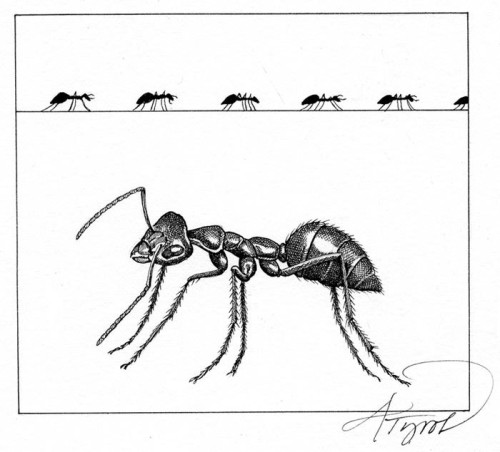
Spring is on our doorstep, and so are the ants. Seeking the open sugar bowl or the drops of maple syrup left on the kitchen counter, they’re a sure sign that winter has finally drifted away. Myrmecologists, scientists that study ants, know these small kitchen ants as Tapinoma sessile, but to most of us they’re odorous house ants, or sugar ants. Whatever you call them, these little ants are likely to be visiting your nest soon.
Named for the faint smell (described as over-ripe bananas) that they emit when squeezed, the odorous house ants in your kitchen are workers. They may have traveled as far as 50 feet, following scent trails left by other workers from the nest to the bounty. Each ant species has a specific chemical it uses to mark trails.
Nicholas Gotelli, a professor of biology at the University of Vermont and coauthor of A Field Guide to the Ants of New England, equates workers to the leaves of a tree. Each worker is just a small part of the colony, which together with other workers and a queen, forms a sort of super-organism. The workers are sterile females dedicated to providing for the queen and the rest of the closely related ants in the colony. The worker’s life is a dangerous one. They live for just a few days to perhaps a few weeks, while queens can live for years to even decades in some species.
Ant colonies overwinter underground or within rotten wood, waiting for spring. Because they are so tiny they are very sensitive to temperature. Most species become active in late March or April in our region.
The pace of work rises with the temperature. With many species, young workers attend to the queen and care for eggs and pupae, while older sisters feed and care for the larvae. The oldest workers are tasked with foraging outside of the nest, maintaining the nest, and defending it from predators and other ants. With a few species, such as carpenter ants, eggs develop into specialized groups of workers. Small workers tend the nest and find food, while large workers defend the nest and food stores. Without a queen ruling the colony, the entire system falls into chaos and the colony disappears.
When the colony has grown to a robust size, the queen will produce winged queens and males. When they mature, they leave the nest en masse on what is called a nuptial flight. The males die after mating and each new queen forms a new colony. Some of these flights can be massive and spectacular. The long-term population changes in some birds, such as common nighthawks, may even be tied to these nuptial flights as important food sources.
Grzesiek Buczkowski, a biologist at Purdue University, found that the odorous house ant has adapted to urban life. "If you go into the forest, the colonies are very small –one queen, maybe 100 ants," said Buczkowski in a recent news release. "But in urban situations, lots and lots of nests are connected by trails, with thousands of queens in just one colony, probably millions of workers. These ants have become more like a non-native, invasive species and have changed the social makeup between colonies to create super-colonies.”
Ants are not just pests, though. They’re garbage collectors, farmers, and ranchers. They even create fertile soil. “Here in New England, ants are the prime movers and creators of soil – not earthworms,” said Gotelli, in a recent University of Vermont news release. Despite their diminutive size, they can create about an inch of topsoil in just a few hundred years. That topsoil is perfect for seeds to take root.
The common forest ant, Aphaenogaster rudis, collects seeds from spring wildflowers such as trillium, bloodroot, and violets. The seeds have a special coating, rich in fat and proteins called the elaiosome. The ants feed on this outer shell, leaving the seed within intact. In this mutualistic relationship, the ants get a great food source and the plant seeds are dispersed and sown in good soils. Seed dispersal would fall by as much as 70 percent if these ants were removed from the forest.
There’s far more to the ant world than those you spot on the counter. There are 130 species of ants known in New England and scientists think there may be another 20 more species or so just waiting for us to discover them.
How do you rid your kitchen of ants? It’s really quite simple. Keep it spotless. Without our sticky, spilled-on countertops, odorous house ants collect sugary honeydew from aphids and other insects on plants. If you remove the food on the counter, the ants will soon be off foraging for their colony elsewhere.

